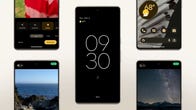Google’s Pixel 7, which was unveiled Thursday, is the company’s next major phone designed to compete with Apple’s iPhone and Samsung’s Galaxy lineup. The Pixel 7 features Google’s new Tensor G2 processor, a camera with improved zoom, face unlock and a slightly updated design — for the same $599 (£599, AU$999) price as last year’s Pixel 6.
The Pixel 7 launches on Oct. 13, with preorders available now.
The Pixel 7 and 7 Pro represent Google’s latest effort to establish a foothold in the global smartphone market, which Samsung and Apple largely dominate. The Pixel 7 is a modest upgrade, unlike last year’s Pixel 6, which was the first phone to feature Google’s self-made Tensor processor and a revamped design.
The Pixel 7’s debut follows the September launch of Apple’s iPhone 14which like the Pixel 7 only features minor improvements over its predecessor.

Google’s latest flagship phones are now available to preorder. Pixel 7 starts at $599 and will be released on Oct. 13. Get up to $750 off with trade-in and $200 in Google Store credit.
Read our Pixel 7 first take.
Google Pixel 7’s new camera
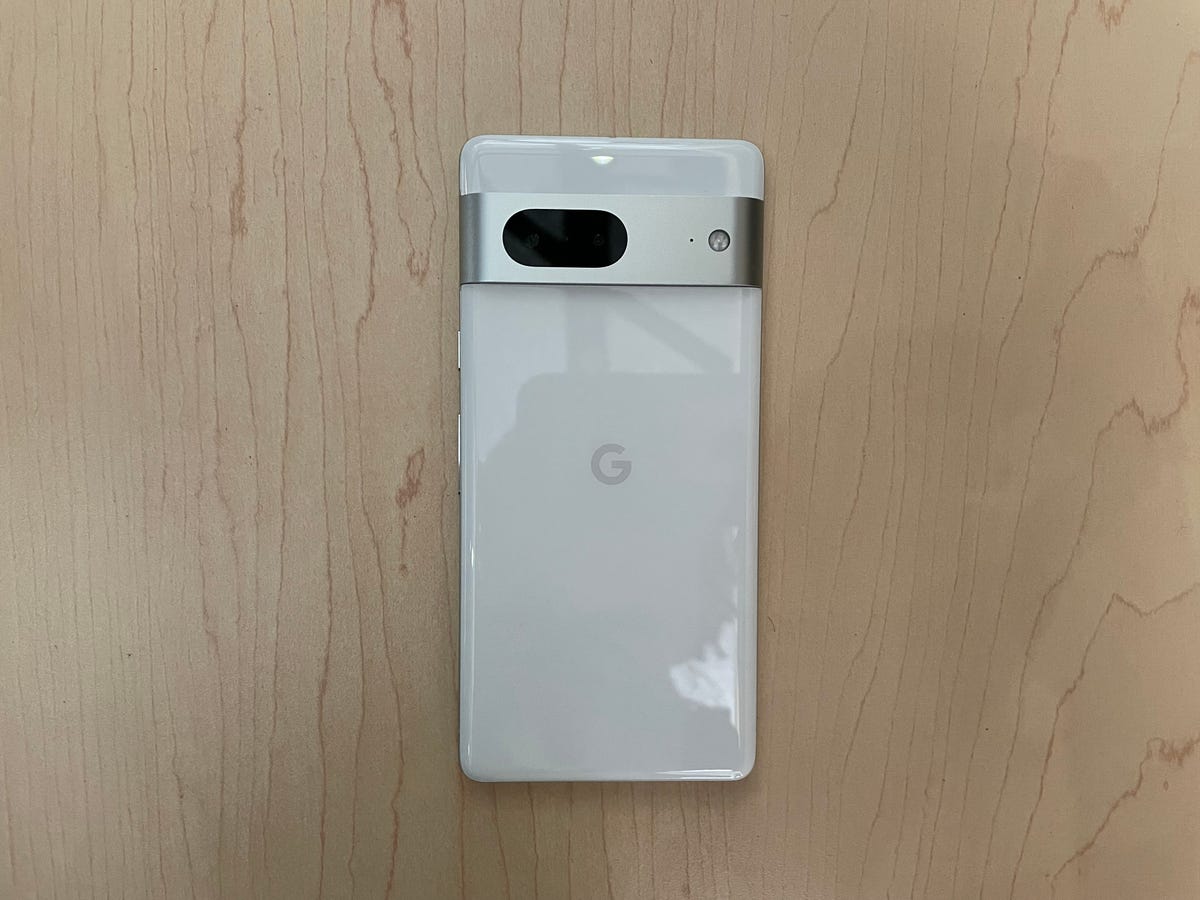
Google’s Pixel 7 has a new camera bar.
Lisa Eadicicco/CNET
The Pixel 7’s camera may look similar to the Pixel 6’s on paper, but there are some behind-the-scenes changes that Google said should make a difference. That’s especially true when it comes to zoom quality.
When zooming at 2x, the Pixel 7’s 50-megapixel main sensor crops into 12.5 megapixels in the middle, which Google said should provide a sharp image that’s similar to the quality of a 2x optical lens. The Pixel 7 can also zoom up to 8x digitally, slightly more magnification than with the Pixel 6’s 7x zoom. I took a few zoomed-on photos at 2x in Google’s demo room and they seemed to look crisp, but it’s almost impossible to tell for sure on a display that small.
However, only the Pixel 7 Pro has a 48-megapixel telephoto lens that can zoom up to 5x optically and 30x digitally. The Pixel 7 Pro is also getting a new macro photography mode that will not be present on the regular Pixel 7.
Night Sight is also said to work faster on both phones, which should make it easier to capture photos in dim environments without blur from shaky hands. Google also said its updated Real Tonethe camera feature designed to capture more accurate skin tones, to further reduce noise and improve images taken in low light.
Google’s new Pixel phones will also have a new camera mode at helping those who are blind or low vision take selfies more easily. The feature, called Guided Frame, audibly tells the user how to position the phone in order to frame a selfie correctly. Google said this feature will be available for all phones with Tensor.
Photo Unblur, henceforth, can sharpen old photos to make them look more in-focus, building on the Face Unblur feature that Google introduced last year. It’s a new tool that you’ll be able to access from the Pixel 7 and 7 Pro’s edit menu, and it’s exclusive to Google’s new phones because it’s on the company’s new Tensor G2 processor.
The Pixel 7 and 7 Pro are getting some video improvements too, such as Cinematic Blur, which is basically Portrait Mode for videos. It’s a lot like Apple’s Cinematic Mode, which it introduced last year on the iPhone 13.
These upgrades seem to be refinements of features that Google has already introduced rather than wholly new features, except for Cinematic Mode, Photo Unblur and Guided Frame. But taken together, they should make Google’s already impressive camera stand out even further.
Google Pixel 7: Face unlock, screen size, design and other details
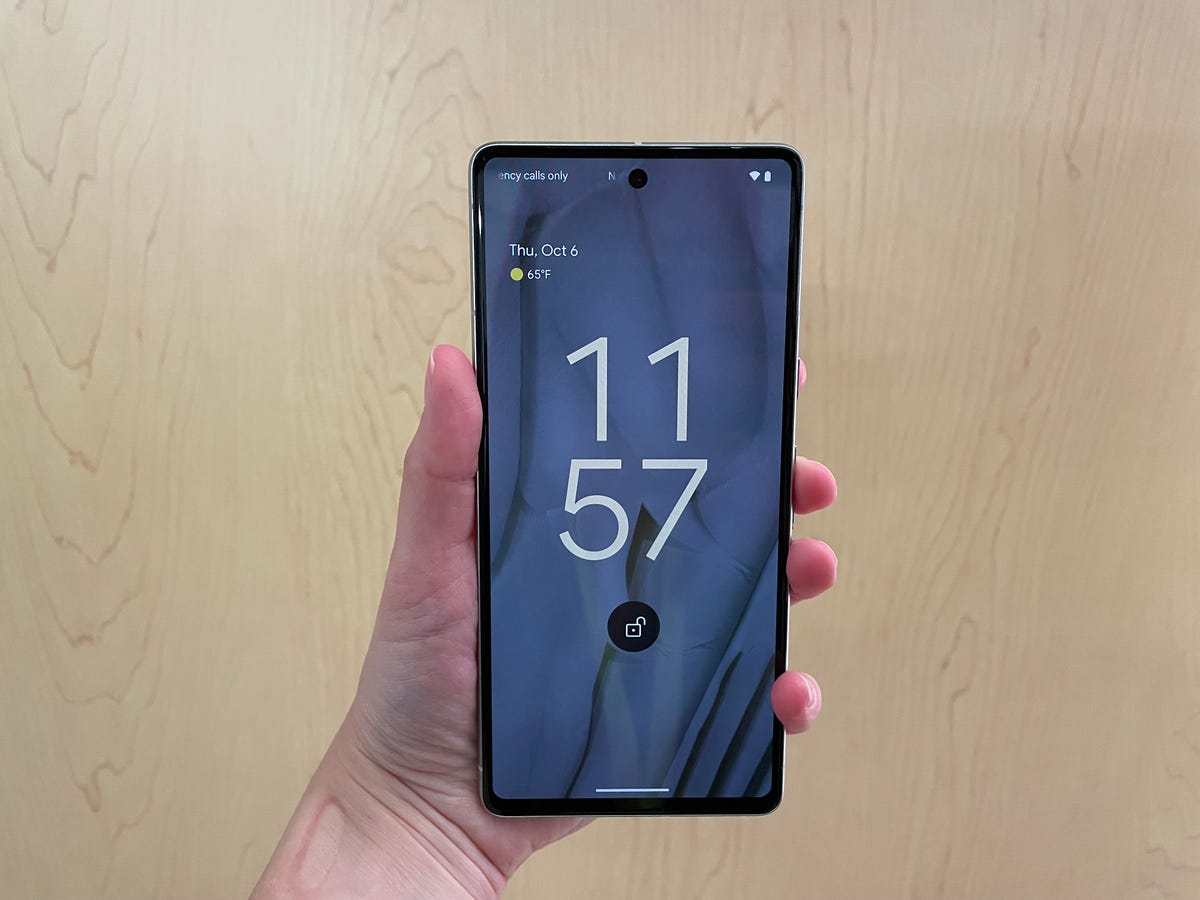
Google’s Pixel 7 has a 6.3-inch screen.
Lisa Eadicicco/CNET
In terms of size, the Pixel 7’s 6.3-inch screen makes it slightly smaller than the 6.4-inch Pixel 6 but larger than the 6.1-inch Pixel 6A. I’ve only spent a few minutes using the Pixel 7, but it seems pretty easy to operate with one hand so far. Not much else has changed here; the Pixel 7’s screen has the same 2,400×1,080-pixel resolution as the Pixel 6’s, but with slightly more pixels per inch (416 versus 411 ppi) given its smaller size. Like its predecessor, the OLED display can also boost up to 90Hz for smoother scrolling.
But there is another significant difference on the front of the Pixel 7. The selfie camera, which has had a resolution upgrade up to 10.8 megapixels compared to the Pixel 6’s 8 megapixels, now supports face unlock. Google cautions, however, that face unlock is less secure than the Pixel’s under-screen fingerprint sensor or a PIN. As such, it’s positioning face unlock as a more convenient way to unlock your phone rather than an authentication method for payments and other sensitive tasks.
The back of the phone has had a refresh as well. While the Pixel 7 and 7 Pro generally maintain the same design language as their older siblings, each has a new metal camera bar that’s more pronounced than those found across the Pixel 6 lineup. The Pixel 7 will be available in black, white and a soft yellow, which Google calls obsidian, snow and lemongrass.
The snow Pixel 7 has a silver metallic, matte camera bar and matching edges that pair nicely with its glossy white exterior. The camera bar’s new look also makes it pop more and draws more attention to the camera lenses. On the Pixel 6, the lenses seem to blend into the camera bar itself.
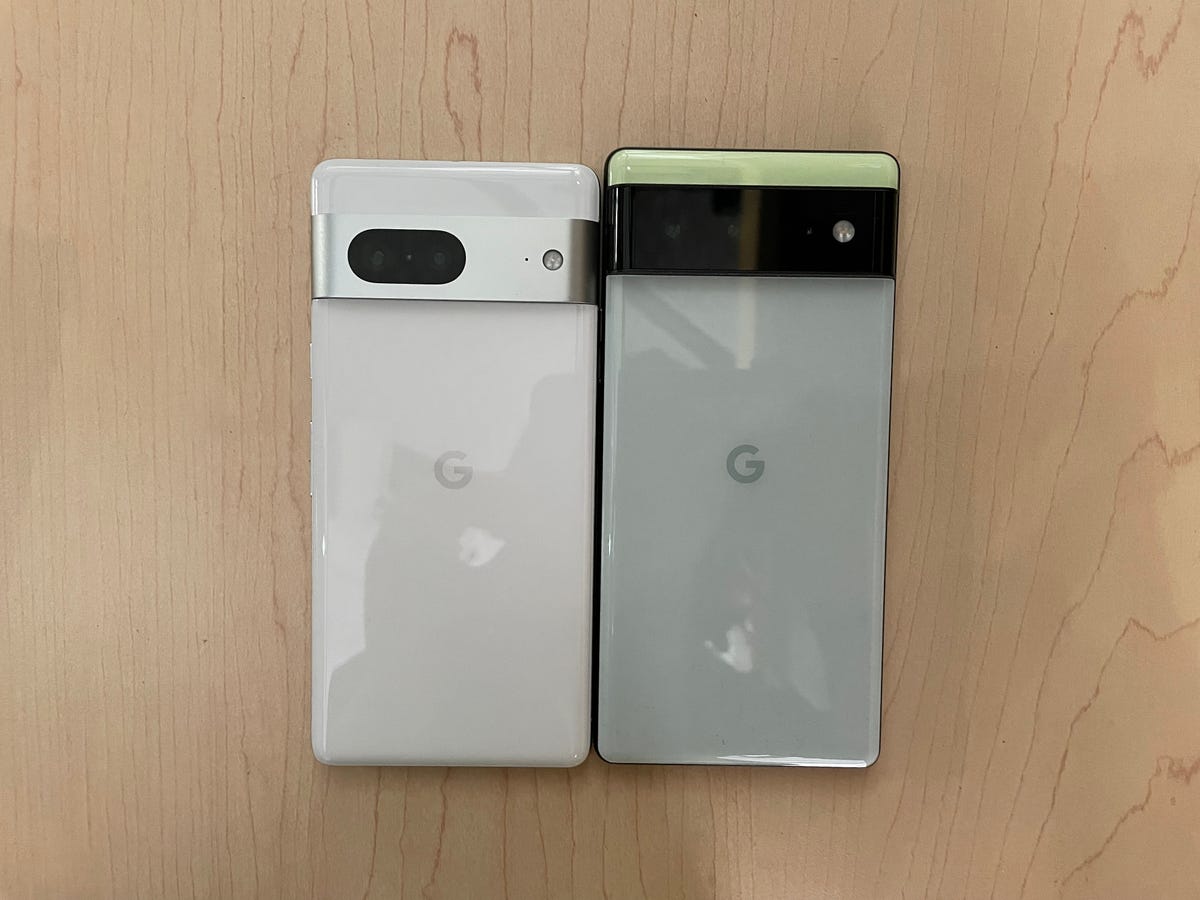
Google’s Pixel 7 (left) next to the Pixel 6.
Lisa Eadicicco/CNET
Both phones support 5G, but access to superfast (yet spatially limited) millimeter-wave 5G connectivity varies depending on the carrier. Unlocked, AT&T and Verizon versions will support millimeter-wave 5G, while only the Pixel 7 Pro will support it on T-Mobile’s network. Google said both Pixel phones should last for more than 24 hours on a single charge and up to 72 hours with Extreme Battery Saver mode turned on. Both phones also support wireless charging and can replenish up to 50% of their batteries in 30 minutes with Google’s 30-watt charger, which is sold separately.
Google is promising five years of security upgrades and three years of general Android OS upgrades for the Pixel 7 and 7 Pro, just like the Pixel 6 and 6 Pro. Samsung, on the other hand, supports four years of Android OS upgrades for its latest Galaxy phones.
Google also discussed some of the new features it will bring to Pixel phones later this year. It will offer VPN service from its Google One service to the Pixel 7 and 7 Pro free of charge. Audio messages will also soon show transcripts, so that you don’t have to listen to messages out loud.
The Voice Recorder app is also getting an update that will add speaker labels to make it easier to distinguish between speakers in a conversation. And Direct My Call, which transcribes automated phone menus, will show the menu in text form right away so that you don’t have to wait for the operator to verbally speak all of the options. That feature will be available at launch.
Google Pixel 7 early thoughts
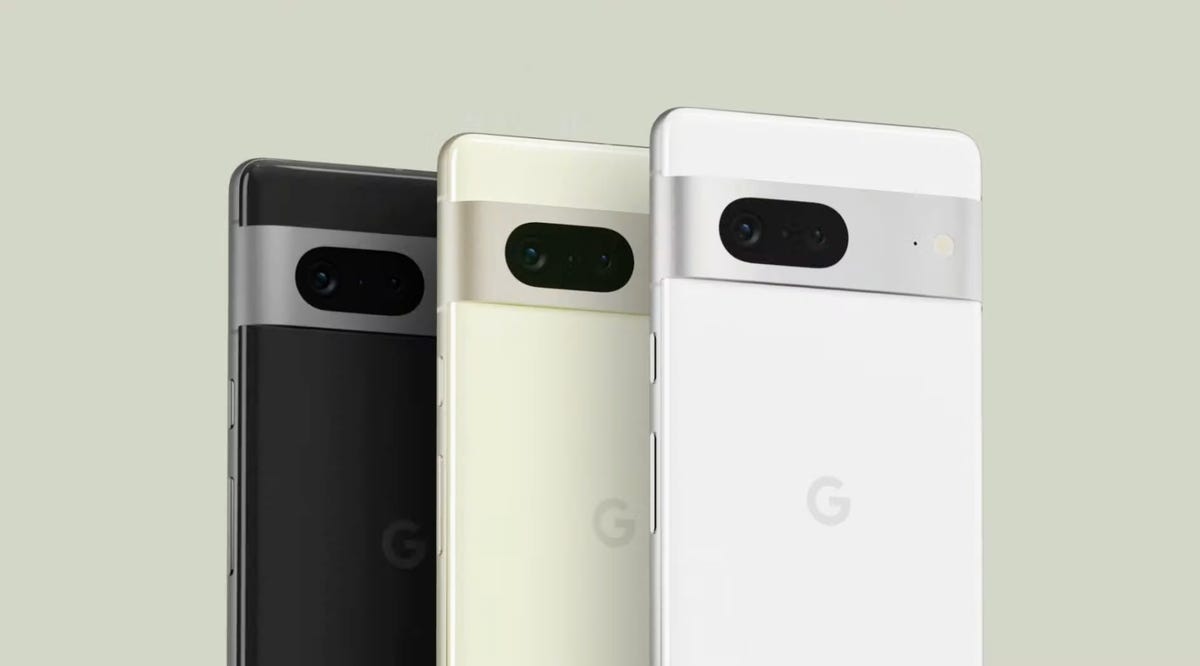
Google’s Pixel 7 shows that it still hopes to compete for market share with Apple and Samsung.
Google/Screenshot by Katie Collins/CNET
The Pixel 7 is a minor upgrade over last year’s Pixel 6, but it underscores Google’s approach to smartphones. It’s another sign that Google hopes to compete against Apple and Samsung by undercutting their prices, launching exclusive software features and focusing on camera quality.
The fact that Google has managed to keep the Pixel 7’s price in the US the same is also significant. While Apple didn’t technically raise the iPhone 14’s price compared to the iPhone 13, it no longer offers a cheaper “Mini” version of the iPhone 14 as it had done the past two years. That means the barrier to entry for Apple’s newest iPhones is slightly higher than it was the past two years.
We’ll know more once we’ve had the chance to test the Pixel 7 and see how much of an upgrade it truly is over the Pixel 6.

